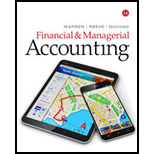
Concept explainers
A.
Accounts receivable
Accounts receivable refers to the amounts to be received within a short period from customers upon the sale of goods and services on account. In other words, accounts receivable are amounts customers owe to the business. Accounts receivable is an asset of a business.
Bad debt expense:
Bad debt expense is an expense account. The amounts of loss incurred from extending credit to the customers are recorded as bad debt expense. In other words, the estimated uncollectible accounts receivable are known as bad debt expense.
Direct write-off method:
This method does not make allowance or estimation for uncollectible accounts, instead this method directly write-off the actual uncollectible accounts by debiting bad debt expense and by crediting accounts receivable. Under this method, accounts would be written off only when the receivables from a customer remain uncollectible.
Allowance method:
It is a method for accounting bad debt expense, where amount of uncollectible accounts receivables are estimated and recorded at the end of particular period. Under this method,
Two methods to estimate uncollectible accounts under allowance method are:
- Percentage of sales method, and
- Analysis of receivables method.
Percentage of sales method:
Credit sales are recorded by debiting (increasing) accounts receivable account. The bad debts is a loss incurred out of credit sales, hence uncollectible accounts can be estimated as a percentage of credit sales or total sales.
It is a method of estimating the bad debts (expected loss on extending credit), by multiplying the expected percentage of uncollectible with the total amount of net credit sale (or total sales) for a specific period. Under percentage of sales method, estimated bad debts would be treated as a bad debt expense of the particular period.
Analysis of receivables method:
A method of determining the estimated uncollectible receivables based on the age of individual accounts receivable is known as analysis of receivables method. This method is otherwise known as aging of receivables method. Under analysis of receivables method, estimated bad debts would be treated as the desired adjusted balance for allowance for doubtful accounts.
To journalize: The write-offs under the direct write-off method.
B.
To journalize: The write-offs under allowance method (Percentage of sales method).
C.
Whether net income of Company RT is higher or lower under the direct-write off method than allowance method.
Want to see the full answer?
Check out a sample textbook solution
Chapter 8 Solutions
CengageNOWv2, 2 terms Printed Access Card for Warren/Reeve/Duchac’s Financial & Managerial Accounting, 14th
- What kind of plant assets are used in a spesific company or place of business? What is the estimate of the amount invested in those plant assets?arrow_forwardHAROUN COMPANY Comparative Income Statements For Years Ended December 31, 2021-2015 ($ thousands) Sales 2021 $ 1,659 2020 $ 1,453 2019 $ 1,322 2018 $ 1,212 2017 2016 2015 $ 1,131 $ 1,052 $ 862 Cost of goods sold Gross profit Operating expenses 1,193 466 356 971 835 731 679 635 506 482 487 481 452 417 356 278 255 188 163 161 134 Net income $ 110 $ 204 $ 232 $ 293 $ 289 $ 256 $ 222 HAROUN COMPANY Comparative Year-End Balance Sheets December 31, 2021-2015 ($ thousands) Assets Cash Accounts receivable, net Merchandise inventory Other current assets Long-term investments Plant assets, net Total assets Liabilities and Equity 2021 2020 2019 2018 2017 2016 2015 $ 104 746 $ 137 2,700 784 1,966 $ 143 710 1,718 $ 146 544 1,447 $ 151 479 1,300 $ 149 454 1,104 $ 154 320 801 69 62 38 69 58 59 31 0 Ө 0 3,305 3,292 2,879 $ 6,924 $ 6,241 $ 5,488 213 1,624 $ 4,043 213 1,680 213 213 1,493 1,281 $ 3,881 $ 3,472 $ 2,800 Current liabilities Long-term liabilities 1,742 1,862 $ 1,465 1,622 $ 961 1,578 Common…arrow_forwardMary carries on business as a sole proprietor that generated $100,000 in net accounting income. Included in this amount are: • $7,000 of amortization expense; • $4,000 for bad debt expense; • $112,000 cost of goods sold; and • $12,000 meals and entertainment with clients. Mary's maximum CCA has been calculated at $10,000 for the year. What is Mary's business income for income tax purposes? A. $113,000 B. $109,000 C. $107,000 D. $103,000arrow_forward
- Please explain the solution to this general accounting problem with accurate principles.arrow_forwardXDR Industries products a single product. The company's absorption costing income statement for April is as follows:arrow_forwardCan you explain the correct methodology to solve this general accounting problem?arrow_forward
- Please explain the correct approach for solving this financial accounting question.arrow_forwardWhat price should sam pay for the bike if he think he can resell it for 9800 ? Solve ths general accounting questionarrow_forwardI need help solving this general accounting question with the proper methodology.arrow_forward
- Can you help me solve this general accounting question using the correct accounting procedures?arrow_forwardCan you explain the correct methodology to solve this general accounting problem?arrow_forwardI need help with this general accounting question using the proper accounting approach.arrow_forward
 Financial And Managerial AccountingAccountingISBN:9781337902663Author:WARREN, Carl S.Publisher:Cengage Learning,Principles of Accounting Volume 1AccountingISBN:9781947172685Author:OpenStaxPublisher:OpenStax College
Financial And Managerial AccountingAccountingISBN:9781337902663Author:WARREN, Carl S.Publisher:Cengage Learning,Principles of Accounting Volume 1AccountingISBN:9781947172685Author:OpenStaxPublisher:OpenStax College Financial AccountingAccountingISBN:9781337272124Author:Carl Warren, James M. Reeve, Jonathan DuchacPublisher:Cengage Learning
Financial AccountingAccountingISBN:9781337272124Author:Carl Warren, James M. Reeve, Jonathan DuchacPublisher:Cengage Learning Cornerstones of Financial AccountingAccountingISBN:9781337690881Author:Jay Rich, Jeff JonesPublisher:Cengage Learning
Cornerstones of Financial AccountingAccountingISBN:9781337690881Author:Jay Rich, Jeff JonesPublisher:Cengage Learning College Accounting, Chapters 1-27AccountingISBN:9781337794756Author:HEINTZ, James A.Publisher:Cengage Learning,
College Accounting, Chapters 1-27AccountingISBN:9781337794756Author:HEINTZ, James A.Publisher:Cengage Learning, Financial Accounting: The Impact on Decision Make...AccountingISBN:9781305654174Author:Gary A. Porter, Curtis L. NortonPublisher:Cengage Learning
Financial Accounting: The Impact on Decision Make...AccountingISBN:9781305654174Author:Gary A. Porter, Curtis L. NortonPublisher:Cengage Learning





